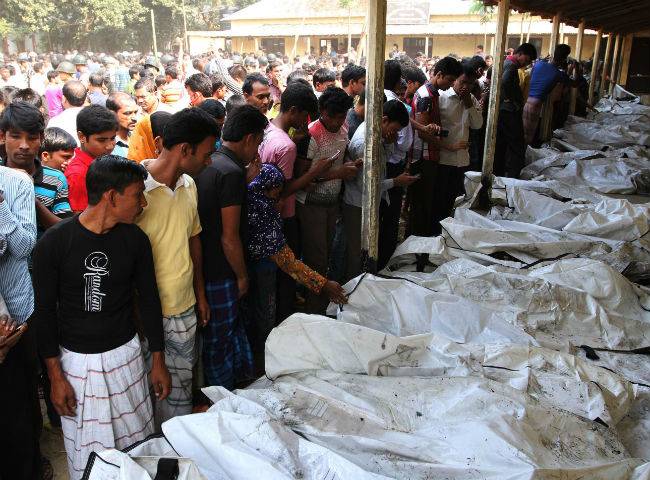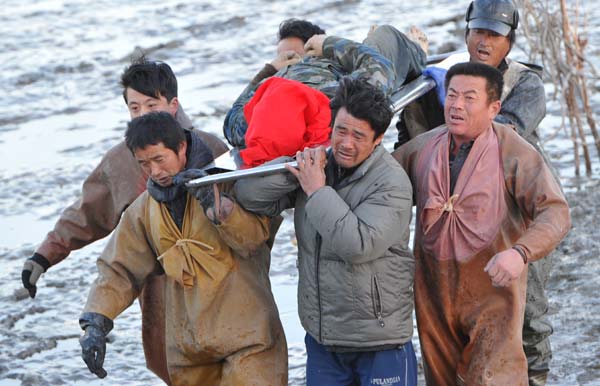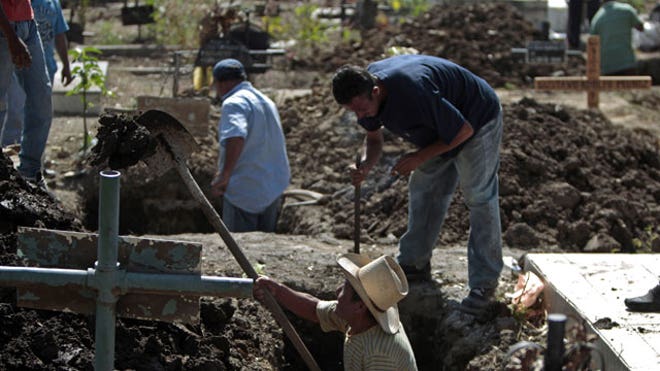
Akram Hossain searched every corner of the fire-devastated factory of Tazreen Fashions Ltd in Ashulia for his wife Lipi Begum.
"Oh, god where do I search for her, now," said a helpless Akram.
It was the third time since Sunday morning that 30-year-old Akram had come to the factory to find out the body of his beloved wife who was also a victim of the Saturday’s fire.
The fire, which broke out at the ground floor of the factory Saturday evening and continued till Sunday dawn, costs the lives of at least 109 workers and left over hundred injured-- worst ever in the history of $20 billion export-earner clothing industry.
Of the dead, 54 bodies, which could not be identified and remained unclaimed, were handed over to the voluntary organisation Anjuman Mofidul Islam.
Akram moved around through the ashes of fabrics, burned flesh, debris of ceramic tiles, sewing machines, charred electric wires and examined everything repeatedly in the hope of finding his wife, whom he had married two and half years ago.
He got nothing but scattered sandals of terrified workers, scarfs, shirts, tiffin-box and shattered windows of the factory, sited at Nischintapur, half a kilometre north off Dhaka-Ashulia highway.
One attendance card of one Ms Zaida was found lying at the third floor near a window which iron grills were broken by the desperate workers to escape the blaze.
To help the families of the deceased, Bangladesh Garment Manufacturers and Exporters Association announced Tk 1 lakh as compensation.
"It is not possible for me to claim an unknown body as my wife only for money. What's the meaning of money if I do not get her," said Akram giving a blank look.
Then Akram recalled the last conversation with his spouse as if it would give him a clue to find Lipi.
He remembered that last time Lipi phoned him when she along with her fellow workers had got trapped inside the building.
Over phone, Lipi informed him that she found no exit staircase to escape the fire, he remembered.
"I am going to die. I am at the 5th floor and could not come out as I am yet to get an escape from the building," said Akram recalling Lipi as saying.
Soon after the phone, Akram, a construction worker, came to the spot and heard terrified screams of trapped workers coming out from the inside of the building that was full of blaze and curling smoke.
He tried to reach Lipi calling her repeatedly over phone after arriving the scene, which seemed as a hell to him.
The cell phone rang till 9:00pm Saturday although he was not lucky enough to hear his wife’s voice any more.
By then he only wished Lipi, just for a single time, to receive his call. After a while the cell phone stopped ringing leaving Akram in whirling despair.
Akram ran to Dhaka Medical College Hospital and other major public hospitals throughout the night but could not find Lipi.
At dawn when fire fighters were trying to bring the blaze under control, he climbed the roof scaling the bamboo stair used for painting and other construction works.
But he could not go to the 5th floor as the fire fighters did not allow him. Later, around 10:00am, he managed to enter the factory but this time heat barred him.
Akram had a hope at a corner of his heart that he would at least find the body of his beloved wife. But the hope also fled like a truant schoolboy when he searched through each floor Sunday afternoon.
"She is a very good and polite girl and never quarreled with anyone. If she told me in which corner she was I would have tried my best to rescue her," said Akram adding that his wife usually came to work with one of their neighbours.
The phone of her fellow worker is also found switched off since last night, he said.
Not only Akram, Saidur Rahman, Hanif and many others were seen searching through the ruins of the factory to find out the bodies of their near and dear ones.
"No dead body, no dead body," Mohammad Hanif told the gathering at the main gate of the factory. He came to find bodies of his two relatives who were worked in the factory on the fateful night.
Hanif said his wife managed to escape the fire by jumping from the third floor. She lost her leg and her chest bones were broken. She has been undergoing treatment now.
A lucky worker who could escape the death is Mamata, a young girl, who joined the factory early this month.
“A male fellow worker helped me to escape the fire. Otherwise, I would have died," said Mamata.
"When the fire broke out and fire alarm rang, manager suggested us not to be worried saying that nothing had happened," said the worker, recalling the horror episode.
The fire broke at the ground floor which was used as a warehouse. Those who were working at the first, second and third floors were the worst victims, said Md Obaidul a survivor who also escaped the fire through the window.
"Hot smoke filled the air within minutes as soon as fire alarm rang and electricity supply became off. We were running to escape death through the dark. Many died inhaling smoke," said Shiria, another woman survivor.
A procession of thousand co-workers, who work at the adjacent factories in Ashulia and Savar, marched through the narrow road of Nischintapur amid the bleak atmosphere.
The procession ends at the factory gate of Tazreen Fashions Ltd as if they were expressing sympathy to the departed mates who only a single day ago were the part of nearly 35 lakh workers whose contribution help Bangladesh to earn 80 percent of exports receipts of $24 billion.
Monday 26 november 2012
http://www.thedailystar.net/newDesign/latest_news.php?nid=42709
 A cargo plane owned by a private company crashed Friday near the airport in Brazzaville, the capital of the Republic of Congo, killing at least three people, officials said.
A cargo plane owned by a private company crashed Friday near the airport in Brazzaville, the capital of the Republic of Congo, killing at least three people, officials said. 


































